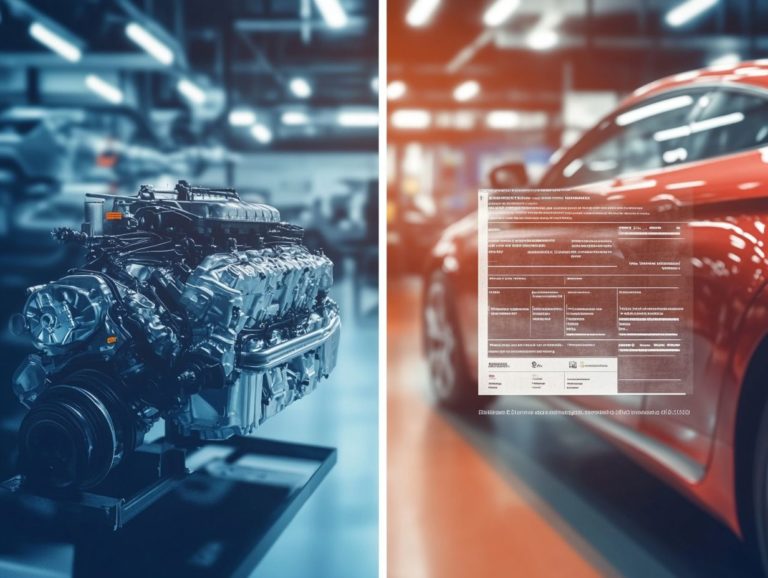How to Read a Car Warranty Document
When it comes to owning a car, grasping the ins and outs of your warranty can save you time, money, and a great deal of stress. A car warranty is a promise from the manufacturer to cover specific repairs and services, but not all warranties are created equal.
Dive into this guide to unlock the secrets of car warranties! You’ll find valuable tips on what to look for in warranty documents and how to maintain your warranty benefits to maximize your coverage.
Contents
- Key Takeaways:
- Understanding Car Warranties
- What to Look for in a Car Warranty Document
- How to Read and Interpret a Car Warranty Document
- Tips for Making the Most of Your Car Warranty
- Frequently Asked Questions
- What is a car warranty document and why is it important to read it?
- How do I know if my car has a warranty and where can I find it?
- What are the different types of warranties and what do they cover?
- What should I look for when reading a car warranty document?
- Can I negotiate the terms of a car warranty?
- What should I do if I have a problem with my car while it is under warranty?
Key Takeaways:
- Familiarize yourself with different types of car warranties to understand what is included and excluded in your coverage.
- Pay close attention to key terms in your warranty document to understand your coverage and limitations.
- Regularly maintain your car and follow recommended guidelines to maximize your warranty benefits and avoid issues with coverage.
Understanding Car Warranties
Understanding car warranties is essential for vehicle owners. It enables you to navigate maintenance complexities while ensuring protection against unexpected repair costs. A car warranty offers peace of mind by covering necessary repairs. However, it’s vital to grasp the different types available, like manufacturer and extended warranties.
This knowledge empowers you to make informed decisions regarding warranty coverage tailored to your vehicle’s needs. A car warranty is a contract with the warranty provider, detailing coverage for specific repairs and services related to your vehicle.
It acts as a shield against hefty repair costs that can arise unexpectedly. Car warranties come in various forms, including those received upon purchase and those you can acquire later.
Each type has its own set of terms, conditions, and durations. They cover everything from major engine repairs to intricate electrical system problems. Regular vehicle maintenance is essential to keep your coverage valid and enhance your overall protection as a consumer.
Types of Car Warranties
There are primarily two types of car warranties: the manufacturer warranty that comes with your vehicle and the extended warranty that you can purchase for added coverage. Each type serves a unique purpose in protecting your vehicle against potential issues.
The manufacturer warranty typically covers defects in materials and workmanship. It offers essential support during the initial ownership years. The extended warranty provides additional protection beyond the manufacturer’s terms, often covering extensive repairs and components not included originally.
Coverage for essential parts like the engine and transmission plays a critical role in these warranties. Understanding these nuances significantly influences your vehicle protection and repair costs.
What to Look for in a Car Warranty Document
When reviewing a car warranty document, grasp the key terms, exclusions, and limitations defining your coverage. Understanding these elements can profoundly impact your warranty claims and the overall protection of your vehicle.
Key Terms and Coverage
Key terms in your car warranty document, such as “warranty coverage,” define the repairs included and limitations that may affect your potential repair bills. Services like roadside assistance are also crucial to note.
Understanding these terms is essential for vehicle owners. They directly impact the financial consequences of unexpected repairs. For instance, roadside assistance might cover services like towing, tire changes, or jump-starts, providing you with peace of mind while on the road.
The specifics of warranty coverage can differ significantly among manufacturers and plans. Review your options thoroughly to make informed decisions about extending coverage or seeking additional protection. This knowledge empowers you to make informed decisions about whether to extend coverage or seek additional protection, ultimately safeguarding you against rising repair costs.
Exclusions and Limitations
Exclusions and limitations in a car warranty can significantly impact your warranty claims process. They delineate what isn’t covered, including certain car problems and parts shortages.
Knowing these exclusions is vital for vehicle owners. It helps prevent unexpected repair costs that may arise when a covered part fails. Many warranties exclude routine maintenance expenses such as oil changes, brake pad replacements, and tire rotations, which are considered part of standard vehicle upkeep. Issues from modifications or aftermarket parts often fall outside warranty coverage, leaving you to foot the repair bill.
This shows why reading and comprehending the terms of any warranty is crucial. By doing so, you empower yourself to make informed decisions and steer clear of potential financial surprises down the road.
How to Read and Interpret a Car Warranty Document
Reading a car warranty document requires attention to detail. It’s essential to grasp the nuances of the language used, helping you identify key clauses that could impact your warranty rights and the level of protection your vehicle receives.
Being thorough in this process ensures you know exactly what you’re entitled to and what to watch out for.
Breaking Down the Language
The language in a car warranty can be confusing, laden with legal jargon that demands careful interpretation. Understanding this terminology directly influences your rights concerning repairs, replacements, and claims.
Terms like “exclusions” and “limitations of liability” may seem intimidating, but they play a vital role in clarifying the coverage available to you. By simplifying these phrases, you can more effectively understand your entitlements and responsibilities.
Grasping these nuances enables you to make informed decisions. Protect your interests when it’s time to file a claim or tackle potential disputes with manufacturers or dealerships. Ultimately, clarity in these documents empowers you to assert your rights with confidence.
Commonly Misunderstood Clauses
Misunderstood clauses in car warranties can cause confusion and potential denial of your warranty claims. This ultimately affects your vehicle protection and results in unexpected repair costs.
Take the term ‘routine maintenance’, for example. The language surrounding it often creates ambiguity. Many owners mistakenly think that all maintenance services fall under this umbrella. They fail to realize that neglecting specific requirements—like timely oil changes—can void their claims.
Conditions about aftermarket parts and modifications can also be misunderstood. While the allure of performance enhancements may be tempting, they could inadvertently breach warranty terms. By clarifying these nuances, you can avoid unwelcome expenses and ensure that your coverage remains intact when you need it most.
Tips for Making the Most of Your Car Warranty
To get the most from your car warranty, it’s important to follow strategies for proper vehicle maintenance. Optimize your warranty benefits for robust consumer protection.
Maintaining Your Car for Warranty Coverage
Maintaining your car regularly is essential for preserving your warranty coverage. Make sure your vehicle maintenance aligns with the manufacturer’s recommendations.
By following the suggested maintenance schedules, you can sidestep potentially costly repairs that might not be covered if you neglect routine servicing. This includes regular oil changes, tire rotations, and brake inspections. These practices keep your car running smoothly and showcase your commitment to care in the eyes of warranty providers.
Familiarize yourself with the specific guidelines outlined in your vehicle’s owner manual. Save those service receipts. Adopting these practices safeguards your warranty and enhances the overall longevity and reliability of your vehicle. Act now to keep your coverage valid!
Maximizing Warranty Benefits
To truly maximize the benefits of your vehicle’s warranty, familiarize yourself with the claims process. Utilize dealership services when needed and take full advantage of offerings like roadside assistance.
Understanding the specific terms of your warranty is crucial. Each policy can differ significantly in terms of how much the warranty pays, what isn’t covered, and the duration of protection.
By maintaining accurate records of all maintenance and repairs, you enhance your claims. Provide evidence that your vehicle has been well cared for. Engaging with customer service representatives during the claims process can offer valuable guidance and clarify any uncertainties you may have.
Being proactive about your warranty details allows you to fully leverage your protections. Don’t wait! Address potential issues now to avoid costly repairs down the road.
Frequently Asked Questions
What is a car warranty document and why is it important to read it?
A car warranty document is a legal agreement between the car manufacturer and the owner that outlines coverage for certain repairs and services. Reading it helps you know your rights and what is covered under the warranty.
How do I know if my car has a warranty and where can I find it?
Most new cars come with a manufacturer’s warranty, which should be stated in the owner’s manual or in a separate warranty booklet. You can ask the dealership or check the manufacturer’s website for more information.
What are the different types of warranties and what do they cover?
The two main types of warranties are bumper-to-bumper warranties and powertrain warranties. Bumper-to-bumper warranties cover most components of the car, while powertrain warranties only cover the engine, transmission, and other major components.
What should I look for when reading a car warranty document?
When reading a car warranty document, pay attention to the length of the warranty, what is covered, what is not covered, any exclusions or limitations, and specific requirements for maintenance. Check for any additional coverage or extended warranty options as well.
Can I negotiate the terms of a car warranty?
In most cases, the terms of a car warranty are non-negotiable. However, you may negotiate certain aspects, such as the length of the warranty or coverage for specific components. Read the document carefully and ask questions before signing.
What should I do if I have a problem with my car while it is under warranty?
If you experience any issues while your car is under warranty, first refer to the warranty document to see if the repairs are covered. If they are, contact the manufacturer or a certified repair shop to have the repairs done. Keep all documentation and receipts for future reference.

.jpg_00.jpeg)
.jpg_01.jpeg)
.jpg_10.jpeg)
.jpg_11.jpeg)



